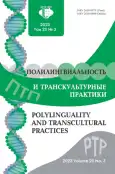Невидимое многоязычие постсоветской миграции как вызов теории транслингвальности
- Авторы: Хилханова Э.В.1, Хилханов Д.Л.2
-
Учреждения:
- Институт языкознания РАН
- Московский городской педагогический университет
- Выпуск: Том 20, № 3 (2023)
- Страницы: 407-425
- Раздел: Языковые процессы
- URL: https://journal-vniispk.ru/2618-897X/article/view/326679
- DOI: https://doi.org/10.22363/2618-897X-2023-20-3-407-425
- EDN: https://elibrary.ru/XETCKC
- ID: 326679
Цитировать
Полный текст
Аннотация
Теория транслингвальности рассматривается с точки зрения ее универсальности / неуниверсальности, ее дополняет новый эмпирический кейс - речевые стратегии и практики высокообразованных многоязычных мигрантов из бывшего СССР и многоязычных жителей современной России. Авторы приходят к выводу, что для людей, чья социализация прошла в этом регионе, характерны жесткие представления о языковой норме и аутентичности, о «чистоте» языков и высоких стандартах говорения на них. Эти представления применяются ко всем языкам, как к родным, так и иностранным. На (пост)советском пространстве распространены традиционные и консервативные языковые идеологии, в силу чего транслингвальность нередко воспринимается как небрежность речи, неполная языковая компетенция. В этом смысле данный региональный кейс свидетельствует о неуниверсальности теории транслингвальности и важности контекстов, в которых формируется отношение к многоязычию, языковой норме и ряду других лингвистических явлений. Именно тем, что теория и практика транслингвальности возникла в демократическом, постколониальном контексте, объясняются не вписывающиеся в нее языковые установки и речевое поведение жителей (пост)советского региона.
Об авторах
Эржен Владимировна Хилханова
Институт языкознания РАН
Email: erzhen.khilkhanova@iling-ran.ru
ORCID iD: 0000-0001-9369-343X
доктор филологических наук, доцент, ведущий научный сотрудник Научно-исследовательского центра по национально-языковым отношениям
Российская Федерация, 125009, Москва, Б. Кисловский пер., 1/1, корп. 28Доржи Львович Хилханов
Московский городской педагогический университет
Автор, ответственный за переписку.
Email: khilkhanovdl@mgpu.ru
ORCID iD: 0000-0002-9382-7757
доктор социологических наук, профессор кафедры философии и социальных наук
Российская Федерация, 105064, Москва, Малый Казенный переулок, 5БСписок литературы
- Khilkhanova, E. 2022. Buryat Migrants in Western Europe: Languages, Ethnic Identities, and Social Networks. In: Father Baikal and his Cosmopolitans. Buryats in Europe. Edited by Stefan Krist, co-edited by Viktoria Adler and Erzhen Khilkhanova, assisted by Monika Haider, Nello Fragner, Nadine Gratzer, Klaus Hofmann and Elisabeth Öfner. Wien: Praesens Verlag. Pp. 163–211. Print.
- Moustaoui, Srhir A., Prego, Vázquez G., Zas, Varela L. 2019. Translingual Practices and Reconstruction of Identities in Maghrebi Students in Galicia. Languages. 4, 3 (63). https://doi.org/10.3390/languages4030063
- García, O. 2009. Bilingual education in the 21st century: A Global perspective. Malden, MA: Basil/Blackwell. Print.
- Canagarajah, S. 2011. Codemeshing in Academic Writing: Identifying Teachable Strategies of Translanguaging. Modern Language Journal 95:401–417. Print.
- Otheguy, R., García, O., and Reid, W. 2015. Clarifying translanguaging and deconstructing named languages: A perspective from linguistics. Applied Linguistics Review 6 (3): 281–307. https://doi.org/10.1515/applirev-2015-0014
- Makoni, S., Pennycook, A.D. 2007. Disinventing and reconstituting languages. In S. Makoni & A. Pennycook (Eds.), Disinventing and reconstituting languages. Clevedon, UK: Multilingual Matters. Pp. 1–41. Print.
- Thibault, P.J. 2017. The reflexivity of human languaging and Nigel Love’s two orders of language. Language Sciences 61: 74–85. Print.
- MacSwan, J. 2017. A Multilingual Perspective on Translanguaging. American Educational Research Journal 54 (1): 167–201. Web. https://doi.org/10.3102/0002831216683935
- Proshina, Z.G. 2017. Translingualism and its application. RUDN Journal of Language Education and Translingual Practices 14 (2):155–170. Print. (In Russ.).
- García, O., Li, W. 2014. Translanguaging: Language, Bilingualism and Education. Palgrave Macmillan. Print.
- Li, W. 2018. Translanguaging as a Practical Theory of Language. Applied Linguistics 39 (1): 9–30. https://doi.org/10.1093/applin/amx039
- Blommaert, J. 2010. The Sociolinguistics of Globalization. Cambridge: Cambridge University Press. Print.
- Khilkhanova, E.V., Khilkhanov, D.L. 2022. Language ideologies in speech practices of multilingual post-Soviet migrants as a barrier to translanguaging. Tomsk Journal of Linguistics and Anthropology 1 (35): 78–91. https://doi.org/10.23951/2307-6119-2022-1-7891 Print. (In Russ.).
- Myers-Scotton, C. 1993. Duelling Languages. Grammatical Structure in Code-Switching. Oxford: Clarendon Press. Print.
- Darieva, Ts. 2004. Russkij Berlin. Migrants and Media in Berlin and London. Münster: LIT Verlag. Print.
- Khilkhanova, E.V. 2021. The Buryat Intellectual Migration to Western Europe from the Perspective of Friendship Connections and Foreign Languages Competencies. Polylinguality and Transcultural Practices 18 (3): 255–267. https://doi.org/10.22363/2618897X-2021-18-3-255-267 Print. (In Russ.).
- Guchinova, E.-B. 2004. The Street Kalmyck road. History, Culture and Identities in the Kalmyk Community of the USA. St. Petersburg: Aleteiya publ. Print. (In Russ.).
- Pischlöger, С. 2016. Udmurt on Social Network Sites: A Comparison with the Welsh Case. In: R. Toivanen, J. Saarikivi (eds.). Linguistic Genocide Or Superdiversity? New and Old Language Diversities. Bristol; Buffalo: Multilingual Matters 14: 108–132.
- Golev, N.D. 2003. The Modern Mental and Linguistic Situation in the Aspect of the Relationship Between its Linguistic and Linguodidactic Aspects. In: Golev N.D. (ed). Natural Written Russian speech: Research and Educational Aspects. Part 2:Theory and Practice of Modern Written Speech: Conference Proceedings. Barnaul: Izd-vo Alt. gos. Universiteta publ. Pp. 178–192. Print. (In Russ.).
- Teplyashina, L.V. 2009. Student mistakes and ways to correct them. Web. URL: https://urok.1sept.ru/articles/527553. (accessed: 25.02.2023). (In Russ.).
- Protassova, E., Suryanarayan, N., Yelenevskaya, M. 2021. Russian in the multilingual environment of three Asian countries. Russian Journal of Linguistics 25 (4): 981–1003. https://doi.org/10.22363/2687-0088-2021-25-4-981-1003
- Dzhundubaeva, A.A. 2017. Descriptive models of pluricentric languages. Universum: Philology and Art history: electronic scientific journal 10 (44). Web. URL: http://7universum.com/ru/ philology/archive/item/5193. (accessed: 22.02.2023). (In Russ.).
- Germanova, N.N. 2016. Linguistic and cultural foundations of the normative grammatical tradition (based on the grammars of the English language of the late XVII — early XX century): PhD thesis: summary: 10.02.19. Мoscow. Print. (In Russ.).
- Rivlina, A.A. 2018. Translation in the era of globalization of the English language and the strengthening of translanguaging. The Humanities аnd Social Studies in the Far East XV (1): 43–49. Print. (In Russ.).
- Cambridge dictionary. URL: https://dictionary.cambridge.org/ru/%D1%81%D0%BB%D0%BE%D0%B2%D0%B0%D1%80%D1%8C/%D0%B0%D0%BD%D0%B3%D0%BB%D0%BE-%D1%80%D1%83%D1%81%D1%81%D0%BA%D0%B8%D0%B9/native-speaker (accessed: 24.02.2023).
- Pujolar, J., O’Rourke, B. 2022. Theorizing the speaker and speakerness in applied linguistics and sociolinguistics. Journal of Applied Linguistics and Professional Practice 16 (2): 207–231. https://doi.org/10.1558/jalpp.22760
- Bergelson, М.B. 2022. Revealing attitudes towards ‘ethnic language’ through paraverbal markers. Report at the International Conference “Multilingual Urban Space: Policy, Identity, Education”. Higher School of Economics, 7–8 April, 2022.
Дополнительные файлы









